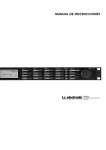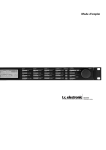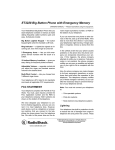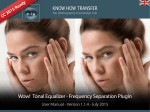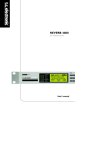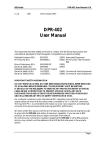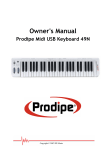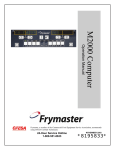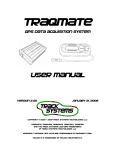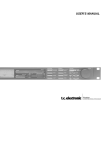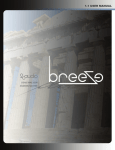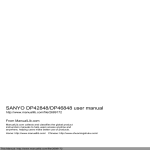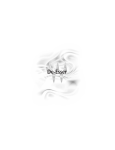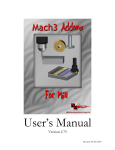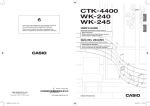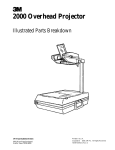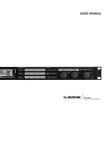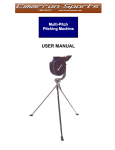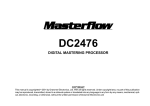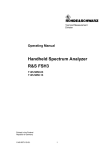Download M2000 JK.qxd
Transcript
USERS MANUAL M2000 STUDIO EFFECTS PROCESSOR 2 TABLE OF CONTENTS WELCOME About this Manual, The help function THE FRONT PANEL Keys, LED’s and other functions explained THE REAR PANEL Inputs, Outputs THE SIGNAL FLOW RECALL SNAPSHOTS, Recalling a Preset, Combined recall, Factory/User presets, Memory card STORE Store a new preset, The letterbox, Combined store THE WIZARD I/O MENU I/O, Input selector, Sample Rate, Mix, Primary output LEVELS MENU Ranges, Auto level ROUTING Serial, Parallel, Dual input, Dual mono, Stereo, Preset glide, Studio setup examples UTIL/MIDI Display, Preset glide, MIDI in, MIDI out, MIDI map, Security, Memory protect, Backup, Pedal TEMPO MENU Tap key, BPM, Tempo subdivisions. MIDI MONITOR TUNER EDIT Combined Edit, Engine output level DYNAMIC MORPHING THE PROGRAMS Reverb, Chorus, Flanger, Delay, Phaser, Pitch, EQ, Tremolo, Stereo, Dynamic THE RESET PAGE Reset page, User data page TECHNICAL REFERENCE TROUBLESHOOTING Maybe you will find help here MIDI IMPLEMENTATION CHART SELF-TEST PROGRAM GLOSSARY PRESET LIST TC Electronic, Sindalsvej 34, DK-8240 Risskov - [email protected] Rev 4 - SW - V 2.06 5 6 8 9 10 12 13 14 15 16 18 20 21 21 22 23 24 30 31 32 33 34 35 36 3 4 WELCOME Congratulations on the purchase of your new M2000. We hope, that you will have as much pleasure using it as we had making it. The M2000 is basically two separate effect Engines housed in the same box. They can be used as such but they can also work together in a number of Combined configurations. The outputs of the two Engines are mixed down to a common stereo output. The general Control of the M2000 is accomplished by moving the cursor with the cursor keys; value changes are made by turning the Adjust wheel. The rest is simple. You select the area that you wish to control by pressing the function keys on the front of the M2000; i.e., if you want to Recall you press the RECALL key. About this Manual Many people in the music business have an aversion to reading manuals. We understand that. So if you feel like starting without reading the whole manual, simply: Plug & Play. You can always use the manual for checking out areas that you have questions about or if you want to dig deeper into the unit. Refer to the Table of Contents for further information. On the other hand, you might want to know a little more about the M2000 before you start pressing keys. The manual will take you step by step through all of the M2000 functions. If you want to read about a specific function, please refer to the Table of Contents. The Help function The Help function is another way to learn your way around the M2000. Simply press Help (Shift - I/O) and the Help function will brief you about functions in the current display. 5 THE FRONT PANEL POWER + MEMORY CARD PPM + INDICATORS SETUP SECTION Electronic power switch »Easy touch« Keep pressed for more than 1sec to turn device off. PPM meters range from -40dB to 0dB I/O Input/output Samplerate Digital/analog selection Dithering. PC-CARD memory card Copy presets to/from a standard memory card. Overload Lights up if internal overload occurs. SampleRate indicator 48000Hz 44100Hz 32000Hz Midi In Midi receive indicator Card Indicates presence of a valid memory card Tempo Beats per Minute indicator Morphing Indicates an on-going morphing 6 Routing Setup the internal routing of the 2 engines. Levels Input/output analog levels Digital input level Util/Midi Viewing angle Security lock Preset handling Pedal input MIDI Secondary functions Help (online help function) Tuner (the tuner you always wanted) Auto level (the fast way to set input levels) Midi monitor (Monitors all midi ch. at the same time) ENGINE 1 OR 2 COMBINED 1+2 CONTROL SECTION Recall Recall presets to engines Recall Recall combined presets. OK Confirms operations. Store Store and name presets. Store Store and name combined presets Shift Enables access to »shifted« secondary functions. Edit Engine mix level Dynamic Morphing Cursors Moves between parameters Edit Edit engine 1 or 2 Bypass Individual bypass key for each engine. Second functions Recall Wizard Find a preset that match your application Delete Preset The fast (and only) way to delete presets Bypass Bypasses the entire device. Adjust wheel Sets parameter values and preset numbers. Snapshots 1-4 Quick store/recall of combined presets Second functions Cancel Page up/down Second functions Recall Wizard Delete Preset 7 THE REAR PANEL Main Power Switch Balanced XLR Inputs Balanced Serial no. XLR Outputs AES/EBU S/PDIF Digital Digital in/out in/out MIDI In,Thru,Out Pedal Input Notes: To accomodate International regulations, we have also added a back panel power switch. You don’t need to use the power switch on the rear panel. Use the front panel power switch instead. Remember to use the left input when you’re using only one input. Pin 2 is »hot« on all XLR’s (AES Regulations). If You are connecting the M2000 to unbalanced equipment, you must tie pins 1 and 3 together in the cable ends away from the M2000. We have reserved the two unused pins on the MIDI connectors for an optional RS485 interface. Therefore, if you are connecting M2000 to other equipment that use these pins, please make sure the cable is a 3-wire standard MIDI type, and not a five wire MIDIPLUS type. If you want to use the pedal input, be sure it is a momentary »make« type. 8 THE SIGNAL FLOW Notes Regarding the signal flow: As shown in the block diagram signals are present on all outputs, all the time. The digital input gain circuit is capable of »lifting« the signal level. This is a very useful feature if you e.g. are feeding the M2000 with a DAT recording that isn´t fully leveled to 0 dB. 9 RECALL + SNAPSHOTS The Recall Displays The Recall display is the »homepage« of the M2000. This means that you return to this display whenever you exit any other display of the M2000. The Recall display is split into two halfs, showing the presets of both Engines at the same time. Engine 1 is always the top half while Engine 2 is the bottom half of the display. If you want to have only one effect, use one engine and set the other in bypass mode. Algorithm type Recall Display Primary parameter Edited flag Preset number Bank indicator (RAM/ROM) Engine 1 Preset name Engine 2 Primary parameters Combined Recall Display Routing mode Flag indicating change to a new routing (only visible during preset preview) Recalling a Preset When you wish to Recall a preset, simply use the ADJUST wheel to scroll through the presets and press OK to Recall. 10 Another way of Recalling is to use the Wizard described later in this section (see »The Wizard«). The Preset number and the OK key will be blinking while you are previewing, indicating that the shown preset is not Recalled yet. Use the Cursor keys (or the other Recall key) to access the other Engine. Combined Recall The M2000 is capable of Recalling Combined presets, meaning a preset for each Engine in a combination. A Combined preset consists of two normal presets and the Routing of the M2000: i.e. by Recalling Combined preset 30, a Chorus will be loaded into Engine 1; a Reverb will be loaded into Engine 2, and the Routing will change to Serial (see »Routing«). To Recall a Combined preset: Press the Combined Recall key and scroll through the presets using the Adjust wheel. Press OK when you find the right preset. The Preset number and the OK key will be blinking while you are previewing, indicating that the shown preset is not Recalled yet. A Combined preset is made out of two normal presets. This means that when you return to the normal Recall display (the Homepage) the M2000 will display the numbers and names of the two presets that the Combined preset consists of. The Edited flag will light if the presets have been modified. presets are available from the Combined Recall. Normal RAM bank: This bank can hold up to 128 of your normal presets. Combined RAM bank: The Combined Ram bank can hold up to 128 of your Combined presets (see Combined presets). The two Ram preset banks are located after the corresponding Rom banks . This means that you scroll through the 128 Rom presets to enter the Ram bank. For fast RAM access press shift and turn Adjust wheel one click to the right. Snapshots The Snapshots are fast Recall keys. Store your favorite presets or use the Snapshots as four compare keys. Factory/User Presets NORMAL COMBINED 128 ROM PRESETS 128 ROM PRESETS Factory presets 128 RAM PRESETS 128 RAM PRESETS Your own presets Preset banks The M2000 contains four different preset banks. Each bank can hold 128 presets. The four banks are as follows: Normal ROM bank: This bank contains 128 normal factory presets. The presets are available from Engine 1 and Engine 2. Combined ROM bank: The Combined bank contains 128 Combined factory presets. The A Snapshot will always include both Presets, and Routing just like a Combined preset. With the Snapshots you are able to switch between completely different configurations with the touch of a single key. TAKING A SNAPSHOT: When you want to Take a Snapshot of your M2000 setup, press Shift and the Snapshot key where you want to store. RECALLING A SNAPSHOT: Recall of a Snapshot is very easy as well: Simply press the Snapshot you wish to Recall and the M2000 will change the whole setup. 11 STORE Store a new RAM Preset - Press the STORE button [Engine 1, 2 or combined] Select a location for your new preset [dial between preset 1 to 128] Move cursor to the new name line and dial in the new preset name [find letter with ADJUST and confirm with OK ] Point on DONE and press OK to finalize store operation. Store with the same name: If you want to Store the Preset with the existing name simply select the RAM location to Store in by using the ADJUST wheel and press OK (the OK key will be blinking while you search for a suitable RAM space). The M2000 will now tell you STORED in a pop-up window and return to the homepage. Store location New preset name Letterbox Place cursor here and press OK to finalize store operation CAPS LOCK Indicator Cursor arrows The letterbox When you want to change the name of the preset to Store, press the Cursor Down key. You are now able to write a new name using the letterbox. Simply dial the ADJUST wheel and press OK to select new letters. Select CAP, by pressing OK, to change case. When you have changed the name select DONE in the Letterbox and press OK to Store. Combined Store The handling of Combined Store is exactly the same as a normal Store. Please note that a Combined Preset Stores the Routing of the Engines along with the Preset. 12 Using a Memory Card: When you wish to use a Memory card, simply insert the Card in the M2000. The M2000 will now autodetect your card and the Store, Recall and Snapshot facilities will be attached to the Memory card. The M2000 will now use the Memory Card as a normal RAM bank. When you remove your Memory card the M2000 will switch back to the internal RAM. If the format of the Memory card is not correct, the M2000 will detect this immediately. Card types Type 1 PC-CARDS, with minimum 64KBytes SRAM. THE WIZARD The Wizard is a tool that helps you find the right preset for your program material. The Wizard is easy to access and simple to use. Try it out, and listen what our creative staff suggests for your program material. How to enter »The Wizard« The Wizard Display Engine 1 or 2 1. Select the type of effect you want 2. Which instrument to be used on 3. and the category of intensity Number of presets utilizing the search criteria Dial here to select between presets that utilize the search criteria. Name of selected preset Press Shift and Wizard to enter the function Use the parameter keys to select the different filters and the Adjust wheel to select filter parameters. Set the three different categories as you desire and try out the proposed presets. The Wizard will show the Name and Number of the proposed preset. Scroll through the Presets using the Adjust wheel and press OK to Recall. You can use the Wizard in many different ways, i.e., set it to enter only Drum Reverbs or use it as a creative partner. Algorithm types Reverb Delay Chorus (including flanging and phasing) Pitch Dynamic (compressor/limiting/expanding/deessing) Misc. Instruments Vocals Guitars Bass Keyboards Percussion Classic instruments (violins, flutes, etc.) Category Gentle Normal Extra 13 I/O Press the I/O key to setup various I/O parameters. Move the marker using the Cursor keys and turn the ADJUST wheel to change values. Input Selector Here you can freeze mix to 100% Input Signal Select Status Bit output: SP/DIF OR AES/EBU standard. Sample rate: 44100Hz, 48000Hz or from digital inputs I/O Press the I/O key to setup various I/O parameters. Move the marker using the Cursor keys and turn the ADJUST wheel to change values. Input Select Input source Analog/Digital. Select Input type Left/Both. When you select Left the right input will be muted. If you are using two inputs you should select Both Sample rate Select Master clock 44.1 kHz/48 kHz/DI. When Digital Input is selected, the external Clock frequency will be displayed by the three LEDS on the left side of the Display. If the M2000 cannot lock, all three LEDs will be blinking. Mix The Mix is a global parameter. When Mix is set to 100% the Mix parameter of all presets will be 100% and no direct signal will pass through the M2000. Note that when Mix is set to 100% the Bypass keys will act like Mute-keys. When Mix is set to Mix, the parameter is adjustable. 14 Indicates the number of bits digital output are dithered to. Automatically set to default value, when changing Status Bit. Status Bit: This selector changes the Channel Status Bits of the digital output between professional and consumer format. When AES is selected, the M2000 will output the professional AES/EBU standard, and when S/PDIF is selected, the M2000 will output the S/PDIF consumer standard. The defaults setting is AES/EBU but some digital consumer products refuses to accept the professional standard. In that case change to S/PDIF consumer standard. Example: If you are using a non-professional DAT machine as a receiver of the M2000 digital output, and you cannot make it accept the digital input, change the output format from AES/EBU to S/PDIF. NOTE: The different Status Bit standards do not affect the quality of the audio output from the M2000. Dither: The M2000 can output Dither from 8 to 22 bit resolution on the AES/EBU and S/PDIF ouput. The dither type is HP-TDF or High Pass Triangular probability Density Function. M2000 uses internal 24 bit resolution and 24 bit AD/DA converters. Dither should therefore only be used when the digital outputs are used (e.g. to a 16 bit DAT machine). It is recommended not to use dither until the final stage of a production, so if there is a chance that the source material is going to be dithered later in a production, do not use Dither. LEVEL MENU Press the Level key to access this menu. These global level controls should be set to optimize the performance of the 24bit AD converter in the M2000. The Level bars can be controlled individually or in common. Mark the level bar you want to control using the cursor keys, and turn ADJUST to change value. For common control the marker should be set between the two Level bars. Note that the Digital In Level is capable of +6 dB gain. Input gain and sensitivity (Consumer/PRO) Output gain and level (Consumer/PRO) Digital input gain Place cursor between L and R to adjust simultaneously Ranges Auto level Analog Inputs Consumer range: -16dB to +10dB Professional range: -6dB to +16dB Press SHIFT and AUTO LEVEL to activate function. Analog Outputs Consumer range: -10dB to +16dB Professional range: -16dB to +6dB Digital Input Level Adjust the Digital Input from: Off to +6dB. Send your expected source into the M2000 and press Auto Level (Shift-Levels) to optimize your Input level automatically. The M2000 will perform a measure for about five seconds and then adjust the Input level giving you about 6 dB of headroom. 15 ROUTING Pressing the Routing key gives you the ability to choose one of six different Routings. Move the marker by pressing the Cursor keys and press OK to accept the new Routing. A small pop-up window will tell you that the Routing has changed. Serial Dual Mono The Serial mode is a Stereo In/Out Routing. The Serial mode is very useful when you want two independent effects in the same signal path; i.e., from a Keyboard through the M2000 Reverb and Chorus to The mixer. This mode is for Dual Mono In/Out Routing. Left In/Out is always ENGINE 1 and Right In/Out is ENGINE 2. The Dual Mono is very useful when you want to use the M2000 as two independent Inserts. Parallel Stereo The Parallel mode is a stereo In/Out Routing. Both Engines will work as stereo effects and their Output will be mixed down to a stereo signal. With this Routing, the M2000 can be used as two parallel effects on the same stereo source. You may also set the I/O menu to left input to get two independent stereo-out effects on the M2000 from a single send on the mixer. When you select the Stereo Routing, the two Engines will link together to perform true Stereo. This means that the preset of Engine 1 will be copied into Engine 2 and the Edit pages will lock together. The Stereo Routing is indicated by the two Edit LEDS which will be lit simultaneously. Left and Right channel audio path are completely separated in this Routing. Dual input (Split mode) Preset Glide The Dual input mode is a Dual mono In / stereo Out Routing. Left In is always attached to ENGINE 1 and Right In is attached to ENGINE 2. Using this Routing enables you to get two different effects with separated inputs; i.e., connect Aux 1 from your Mixer to Left In and Aux 2 to Right In. You now have access to two separate effects with a common stereo output. Set the individual Preset output volumes to achieve the correct effects balance. When the Preset Glide Routing is selected, the M2000 will perform preset changes by crossfading the current Effect and the new preset. This gives you a very smooth change of effects; i.e., allowing a Delay to keep repeating while a Chorus is being faded in. The glide time is located in the Utility menu (see Util/MIDI). Please note that only one Engine is available while the M2000 is in the Preset Glide Mode. 16 STUDIO SETUP EXAMPLES Use two sends on your mixing console Dual Input mode Lets say Engine1 is running a long Hall-type reverb and Engine 2 a short more ambient type of reverb. On Your mixing console youll now have individual sends for the two effects. And - not to forget - you are saving a set of return channels. Create your own vocal reverb Serial mode You probably always wanted to have a long bright reverb on your lead vocal, without »esses« hanging for seconds. Thats now possible. You simply connect a »deesser« and your favorite reverb in serial. The de'esser will cut away all sharp transients in the signal. If you want your vocal to have a unique »livingness«, or the reverberated signal to be slightly detuned, simply connect the pitch shifter or chorus in series with the reverb. There are numerous applications in this mode - try them out. Two individual inserts on your mixer Dual mono mode In the dual mono mode you are able to use two completely separate mono effects at the same time. It can be equalizers or compressors or whatever you can imagine. Post Production Stereo mode When running in stereo mode both engines are linked in stereo and both channels audio path are totally separated. This means that you can process Dolby Surround materials without destroying the hidden information. Use this mode when adding reverb to your recording. 17 UTIL/MIDI How to move around In the Util/MIDI menu you always move by pressing the Cursor keys and change values by dialing the Adjust wheel. Display Viewing Angle: Adjust for best contrast on the LCD display. Preset glide: Glide time This parameter sets the glide time of the incoming preset. The parameter is only active when Preset glide Routing is selected (See Routing). In the MIDI section you are able to see the MIDI setup of both Engine 1, Engine 2 and the Combined section at the same time. MIDI In Channel Sets the Channel of which the current Engine will respond to. When set to Omni the Engine will respond to all channels, When set to off no MIDI will be received. Filter Sets whether the current section of the M2000 should respond to MIDI Control changes (CTRL) and MIDI Program changes (PROG) or not; i.e., when Filter is set to PROG the M2000 will only respond to MIDI Program changes. Offset With this parameter, you are able to add or subtract to the incoming Program change; i.e., the incoming Program Change is preset 123, and the Offset is set to +1, the Program Change will now be 124. Sys-ex id Sets the Sys-Ex ID number of the M2000. 18 MIDI Out Memory Protect Channel Sets the sending MIDI channel of the M2000. Filter Sets wether the current section of the M2000 should send out MIDI Control changes (CTRL) and MIDI Program changes (PROG) or not; i.e., when Filter is set to PROG the M2000 will only send out MIDI Program changes. Offset With this parameter you are able to add or subtract to the outgoing Program change; i.e., the outgoing Program Change is preset 123, and the Offset is set to +1 the Program Change will now be 124. Protect This parameter sets the Memory protect On or Off. When the Protect is activated the Ram presets inside the High and Low limit are write protected. Low Lim Sets the Low limit of the Memory protect. The current number is included in the Protect. High Lim Sets the High limit of the Memory protect. The current number is included in the Protect. Snapshot Protect Enables or disables the Protect of the Snapshots. When activated the Snapshots are write protected. MIDI Map MIDI Map Sets the current MIDI Map On or Off. Prg. Bank Determines which Bank the MIDI Map should control; Ram/Rom. Prg. In The current Program change Maps to a M2000 program (See Maps to). Maps to The current incoming Program change set in Prg. In will be changed to the Program number of this parameter. Reset Map Press OK while this parameter is selected and your MIDI Map will be Reset. Security Security Lock Press OK while this parameter is selected to Security lock the M2000. When locked, you will have to dial the PIN-Code shown below to access the M2000. PIN-Code Set your own PIN-code for the Security lock by Dialing the Adjust Wheel. If you should forget your PIN-code, please enter the Reset page. This will release M2000 from the locked state. (You do not have to run any of the reset functions). Memory Backup Mem > Card Insert a PC-CARD Card in the card-slot and press OK. All Ram presets of the M2000 will now be backed up to the Memory Card. Card > Mem Insert the PC-CARD Card containing your presets and press OK. All Presets will now be Stored back into the M2000 Ram. Warning: This action will destroy ALL existing Ram Presets of the M2000. Mem > Midi Connect your M2000s Midi Out to a another M2000, a Sequencer or any other Midi Recordable device. Press OK and the M2000 will perform a Midi bulk dump of all Ram Presets. Midi > Mem Connect the Storing device to the M2000s Midi In and press OK. The M2000 is now ready to receive a Midi bulk dump containing Ram presets. WARNING this action will destroy ALL existing Ram Presets of the M2000. Pedal Pedal The Pedal input can control any one of four different features: Engine 1 Bypass, Engine 2 Bypass, Engine 1+2 Bypass and Tap tempo. Select by turning the Adjust Wheel. 19 TEMPO Tapped or dialed BPM Which engine to work on Define subdivision beat Tapped time in ms. Tapped time in ms. corrected with the subdivision factor. Tap Tempo The Tap Tempo key is similar to its cousin Learn on the TC 2290 Digital Delay. Only the M2000 Tap Tempo key can control various parameters: Delay time, Decay time, Chorus speed, etc. When you press the Tap key, a Tempo menu pops up. If no further actions are made, the Tempo menu will disappear after a few seconds. The Tap key is attached to a default parameter in each effect type. This means that the function of the Tap key changes along with the presets (See default list later in this section). The Tempo Menu The Tempo you tap is always measured in BPM (Beats Per Minute). The Tempo menu is able to recalculate the tapped time into Subdivisions of the BPM. Simply set the Tempo menu to the Subdivision you like and Tap the BPM on the Tap Tempo key. You also have the possibility of changing the Tempo using the BPM parameter in the Tempo menu. When a preset has been Tapped, the parameter attached to the Tap function will be displayed in BPM in the Tempo Menu. Tempo BPM The BPM will display the Tapped tempo (BPM is equal to the 1/4 Subdivision). You can also set your Tempo with this parameter using the ADJUST wheel. Subdivision Sets the subdivision of the Tempo. If the Subdivision is set to 1/8, the actual Tempo will be twice as fast as the tapped time, etc. The following subdivisions are possible: 1,1/2,1/4,1/4T,1/8,1/8T,1/16,1/16T,1/32,1/32T (T for triplets). 20 Tap/Subdivision This is read only parameters displaying the tapped time and the Subdivided time in milliseconds. Tap Time Subdivision is corresponding to the parameter in your preset. The parameters controlled by the Tap key Reverb Delay Chorus Flanger Phaser Tremolo Panner Decay parameter Delay time Speed Speed Speed Speed Speed Press and hold TAP for 3 seconds to learn MIDI tempo (MIDI-Clock). MIDI MONITOR & TUNER »MIDI MONITOR SCREEN« Program changes Note on/off Controllers System exclusive Engines MIDI channels Channel pointer »TUNER SCREEN« Deviation in cents Tuning guide Tuning guide Select guitar/bass or note set manual Detected note Master tune 440-445Hz MIDI Monitor Tuner In the MIDI Monitor, you are able to see all MIDI actions received by the M2000. The actions are displayed according to the current channels. When Tuner is selected, the Outputs will be muted. Select Guitar/Bass/Manual mode by turning the ADJUST wheel. When Guitar or Bass is selected, the Tuner will only respond to notes corresponding to the strings of these instruments. When set to Manual, you must select the desired Note using the ADJUST wheel. In the Master section, you can Calibrate the Tuners default, 440445 Hz. The detected note will be shown in the lower right corner and in the note line. When the horizontal marker is 0, you are tuned in. The two tuning guides will tell you wether the note is too flat or too sharp. Press Shift - Util/Midi to access MIDI Monitor. Prog. Note Cntl Sys-x Eng Chan Displays Program changes. Displays Note On/Off. Displays Control changes Displays System exclusive commands Displays the midi channels of Eng 1,2 and combined. Displays the Midi channels Press any key to exit MIDI Monitor. Press Shift - Routing to access the Tuner of the M2000. Press any key to exit Tuner. 21 EDIT Algorithm been edited Subtitles Values Parameters Edit In the Edit menu, you always move by pressing the Cursor keys and change values by dialing the Adjust wheel. Expert mode When pressing OK on the Expert line, the M2000 will enable you to access a detailed Edit mode of the Reverbs. Since the two different Edit modes (User & Expert) are not compatible, it is NOT possible to return to the User Edit mode. When Storing a preset Edited in Expert mode, the current preset will remain in expert mode forever. 22 Combined Edit See illustration on next page The relative Levels of the two Engines can be adjusted in this display. The range is: off - 0.0 dB. These levels affect both analog and digital outputs. Move the marker by pressing the Cursor keys; change values using the Adjust wheel. The Engine Out Levels are identical with the Outlev. parameter in the Edit page and will, at all times, be corresponding with these. DYNAMIC MORPHING Engine output levels [mix] Engine output levels Dynamic Morphing section Morphing on/off and morphing direction Morphing speed Morphing threshold Dynamic Morphing The Dynamic Morphing function is a great new way of interaction between your source signal and the Effect. When activated, the M2000 will morph between the two Engines according to your Input level. This is a function for quick seamless changes of an Effect. Think about the vocal in a ballad being soft and subtle during the verse and then rising to heartbreaking heights in the chorus. Now imagine the Reverb changing along with it, from a small discreet Room in the verse, to a Big Bright Hall in the chorus. Simply select the two presets in the current Engines and then activate the Dynamic Morphing function. Set the Threshold and the Speed of the Dynamic Morphing and check out the result. Morph direction 1-2: If this box is selected, Engine 1 will be active while the Input is below Threshold. Morph direction 2-1: If this box is selected, Engine 2 will be active while the Input is below Threshold. Note that the max. level of the Engines is set by the Engine Out bars above Dynamic Morphing. The Dynamic Morphing is Stored along with Combined Presets. The Dynamic Morphing function is only available when Routing is set to Parallel. 23 THE PROGRAMS Reverb Programs HALL-ROOM-PLATE-AMBIENCE-GATED All Reverb presets both have a User and an expert page. The number of parameters depends on which preset you have selected. USER PARAMETERS Decay Sets the decay time. The value indicates the time to where the reverb tail is damped to -60dB. Pre-delay The time to arrival of the first reflection. Reverb Lo Adjust the low frequency reverberation time. Reverb Mid Adjust the mid frequency reverberation time. Reverb Hi Adjust the high frequency reverberation time. Expert mode Press OK here to enter expert mode. Remember there is no way back to normal user parameters, after adjusting any expert parameters. HiCut freq. Sets the cutoff frequency of the HighCut filter. HiCut level Damping ratio in dB of the HighCut filter. Mix Mix between direct and effect. Out Level Adjust output level. Use this parameter to match levels between presets. EXPERT PARAMETERS (only additional parameters mentioned) Diffuse This parameter sets the degree of wall diffusion. Increasing 24 the value will result in a more dense reverberation tail. Dont set the value too high, as it will result in a not natural sounding reverberation tail. Room shape Here you can choose between different room shapes. Changing the room shape will change the initial reflections. Size mult. Size multiplication factor. With this parameter you can change the size of the room. Only the initial reflections are influenced by this factor. Lo Crossover Crossover frequency between low and mid band reverberation filter. Mid Crossover Crossover frequency between lo-mid and hi-mid band reverberation filter. Hi Crossover Crossover frequency between mid and high band reverberation filter. Initial lev. Sets the Initial reflection level. Rev.lev. Level of the reverberation tail. Rev.width This parameter adjust the stereo width of the reverb tail. Rev Feed Determines how fast the reverberation will build up. Rev.diff Imposes the characteristics of the early reflections on the later reverberation. Distance The relative distance control varies the mix relations between early and later reflections. Simulating how far away you are from the sound source. Difusor type The natural room mode peak frequencies and the smoothness of the tail are affected by this parameter. Mod Rate The MODRATE varies the rate of modulation of the recirculating delay paths simulating the reverb tail. Mod Depth Controls the amount of delay path modulation or "wander" in the reverb. Chorus Programs Flanger Programs USER PARAMETERS USER PARAMETERS Speed Controls the rate of sweep in a range from 1 sweep every 10 seconds to 10 sweeps every second. Depth Determines how wide a modulation (sweep) is produced. Phase Determines the sine wave modulation phase shift between left and right channels. At 0º the left and right modulation will move in sync. At 180º the modulation will move the channels against each other. HiCut Freq. Hicut shelving type filter (6dB/oct). This parameter sets the »hinge« point of the shelving filter. HiCut Level Sets maximum depth of cut above the HiCut shelving frequency. Delay Controls the length of delay time. Mix Mix between direct and effect. Out Level Adjust output level. Use this parameter to match levels between presets. Speed Controls the rate of sweep in a range from 1 sweep every 10 seconds to 10 sweeps every second. Depth Determines how wide a modulation (sweep) is produced. Phase Determines the sine wave modulation phase shift between left and right channels. At 0º the left and right modulation will move in sync. At 180º the modulation will move the channels against each other. FB Level Controls the amount of effect signal routed back to the flanger inputs. Select negative feedback to change feedback phase. Delay Controls the length of delay time. FB HiCut Feedback High Cutoff frequency. Signal is damped 6dB/oct above this frequency. FB LoCut Feedback Low Cutoff frequency. Signal is damped 6dB/oct below this frequency. HiCut Freq. (see chorus) HiCut Level (see chorus) Mix Mix between direct and effect. Out Level Adjust output level. Use this parameter to match levels between presets. These presets are capable of producing a smooth natural sounding stereo chorus effect. The Hicut filter gives you the ability to make it sound very warm. The Presets range from very soft add-on effects to the wildest guitar sound you can imagine. The Feedback filters are capable of controlling both high frequency and low frequency feedback. 25 THE PROGRAMS... continued Delay Programs The Delay presets are capable of performing up to 1200 ms delay. The Feedback filters makes it possible to control both high and low frequency feedback. Phaser Programs USER PARAMETERS USER PARAMETERS Delay Controls the length of delay time. FB Level Controls the amount of effect signal routed back to the input. FB HiCut Feedback High Cutoff frequency. Signal is damped 6dB/oct above this frequency. FB LoCut Feedback Low Cutoff frequency. Signal is damped 6dB/oct below this frequency. HiCut Freq. Hicut shelving type filter (6dB/oct). This parameter sets the »hinge« point of the shelving filter. HiCut Level Sets maximum depth of cut above the HiCut shelving frequency. Mix Mix between direct and effect. Out Level Adjust output level. Use this parameter to match levels between presets. 26 Intensity Phaser intensity. Speed Controls the rate of sweep in a range from 1 sweep every 10 seconds to 10 sweeps every second. Depth Determines the depth of modulation. HiCut Freq. Hicut shelving type filter (6dB/oct). This parameter sets the »hinge« point of the shelving filter. HiCut Level Sets maximum depth of cut above the HiCut shelving frequency. Mix Mix between direct and effect. Out Level Adjust output level. Use this parameter to match levels between presets. Multi Pitch-shift Programs The Multi pitch presets are capable of performing 6 pitched Voices at the same time. This makes it possible to produce a true chorus effect. USER PARAMETERS Mix Mix between direct and effect. Out Level Adjust output level. Use this parameter to match levels between presets. Voice Sets which voice you are editing. Pitch Sets the pitch of the current Voice (0-1200). Level Sets the level of the current Voice. Pan Sets the panning of the current Voice. Delay Sets the Delay of the current Voice. 27 THE PROGRAMS... continued EQ Programs The EQ programs are all 3 band parametric types with separate high and low shelving bands. Tremolo Programs The Tremolo programs are effects where the output level is modulated by an LFO. Our programs are able of setting the LFO phase between the two outputs. USER PARAMETERS Frequency Low shelving filter ranges from 20hz to 5Khz High shelving filter ranges from 500hz to 20Khz Three band filters ranges from 20hz to 20Khz Band width Low and high shelving filters have 2 different bandwidths The 3 bandfilters have 3 different bandwidths Level All filters range +/- 12dB. EQ level Adjustable +/-12dB. 28 USER PARAMETERS Speed Controls the rate of sweep in a range from 1 sweep every 10 seconds to 10 sweeps every second. Depth [intensity] Determines how wide a modulation (sweep) is produced. Phase Determines the sine wave modulation phase shift between left and right channels. At 0º the left and right modulation will move in sync. At 180º the modulation will move the channels against each other. Mix Mix between direct and effect. Out Level Adjust output level. Use this parameter to match levels between presets. Stereo Programs Dynamic Programs COMPRESSOR-LIMITER-GATE-DE'ESSER USER PARAMETERS Spatial Controls the amount of spatial expansion. HiCut Freq. Hicut shelving type filter (12dB/oct). This parameter sets the »hinge« point of the shelving filter. HiCut Level Sets maximum depth of cut above the HiCut shelving frequency. Mix Mix between direct and effect. Out Level Adjust output level. Use this parameter to match levels between presets. USER PARAMETERS Attack Dynamics attack time. Release Dynamics release time. Ratio Compression ratio. Threshold (compressor) Adjustable threshold level. The compressor will be engaged above this level. Threshold (limiter) Adjustable threshold level. The limiter will be engaged above this level. Threshold (expander) Adjustable threshold level. The expander is active below this level. Gain (make-up gain) The gain parameter compensates for the compression gain loss. Deessing frequency The de'essers attack frequency. Deess damp The damping ratio of unwanted »esses«.. 29 THE RESET PAGE Store and load your own default settings Enter UserData page Reset system parameters Clear all user presets Test Programs Type your name here and your phone number Place cursor here and press OK to finalize session. How to enter the Reset page: Hold one of the 3 Bypass keys pressed while power-up. Move the marker using the Cursor keys and press OK to select the RESET type you desire. Load User Default This will reset all system parameters back to a Default setup made by you (See Store User Def). This reset will NOT delete the User presets of the M2000. Store User Def When you have a perfect setup of your M2000, you are able to Store this as your own Default setup. This function is very useful, for example when you have finished a special production and want to go back to normal. When you have the perfect setup of your M2000, simply select this parameter and press OK to store your Default settings. 30 Set User Name This function makes it possible to write your Name and Phone number into the M2000. Press OK to access the User data menu. Use the ADJUST wheel and the Cursor keys to write your Name and Phone number into the M2000. Press OK to accept. Your Name and Phone number will be displayed during power-up. Reset System Parameters This will reset all system parameters back to the Factory Default. This reset will NOT delete the User presets of the M2000. Reset all Presets This will Clear all Ram Presets . TECHNICAL SPECIFICATIONS Digital Inputs and Outputs Connectors: Formats: Output Dither: Sample Rates: Processing Delay: Frequency Response DIO: XLR (AES/EBU), RCA Phono (S/PDIF) AES/EBU (24 bit), S/PDIF (20 bit), EIAJ CP-340, IEC 958 HPF TPDF dither 8 to 24 bit 32 kHz, 44.1 kHz, 48 kHz 0.2 ms @ 48 kHz DC to 23,9 kHz ± 0,01 dB @ 48 kHz Analog Inputs Connectors: Impedance: Max. Input Level: Min. Input Level (for 0 dBFS): Sensitivity: A to D Conversion: A to D Delay: Dynamic Range: THD: Frequency Response: Crosstalk: XLR balanced (pin 2 hot) 20 kohm +22 dBu (balanced) -10 dBu @ 12 dB headroom: -22 dBu to +10 dBu 24 bit (1 bit, 128 times oversampling) 0.8 ms @ 48 kHz >103 dB (unweighted), >106 dB(A) -95 dB (0,0018 %) @ 1 kHz, -6 dBFS (FS @ +16 dBu) 10 Hz to 20 kHz: +0/-0.2 dB <-80 dB, 10 Hz to 20 kHz, typical -100 dB @ 1 kHz Analog Outputs Connectors: Impedance: Max. Output Level: Full Scale Output Range: D to A Conversion: D to A Delay: Dynamic Range: THD: Frequency Response: Crosstalk: XLR balanced (pin 2 hot) 100 ohm (active transformer) +22 dBu (balanced) -10 dBu to +22 dBu 24 bit (1 bit, 128 times oversampling) 0.57 ms @ 48 kHz >100 dB (unweighted), >104 dB(A) -86 dB (0.005 %) @ 1 kHz, -6 dBFS (FS @ +16 dBu) 10 Hz to 20 kHz: +0/-0.5 dB <-60 dB, 10 Hz to 20 kHz, typical -90 dB @ 1 kHz EMC Complies with: Safety Certified to: Environment Operating Temperature: Storage Temperature: Humidity: PCMCIA Interface Connector: Standards: Card Format: Control Interface MIDI: GPI, Pedal, Fader: General Finish: Dimensions: Weight: Mains Voltage: Power Consumption: Backup Battery Life: Warranty Parts and labor: EN 55103-1 and EN 55103-2 FCC part 15, Class B. CISPR 22, Class B IEC 65, EN 60065, UL 1419, CSA E65 32° F to 122° F (0° C to 50° C) -22° F to 167° F (-30° C to 70° C) Max. 90 % non-condensing PC Card, 68 pin type 1 cards PCMCIA 2.0, JEIDA 4.0 Supports up to 2 MB SRAM In/Out/Thru: 5 Pin DIN 1/4” phone jack, 0 ohm to 50 kohm Anodized aluminum front, Plated and painted steel chassis 19" x 1.75" x 8.2" (483 x 44 x 208 mm) 5.2 lb. (2.35 kg) 100 to 240 VAC, 50 to 60 Hz (auto-select) <20 W >10 years 1 year 31 TROUBLESHOOTING You press the POWER switch but there is no light. - The power switch on the rear panel is switched off. The input PPM meters dont peak out. - You are using analog inputs, but the input selector in the I/O menu is set to digital in. - The analog input level is set too low. Only left input PPM meter is showing a signal. - Set input selector (in I/O menu) to Both No sound through the M2000. - You are using analog inputs, but the input selector in the I/O menu is set to digital in. You cant turn the power off. - Hold the power switch pressed for at least 3 seconds. All Program sounds »phased« - You are using the M2000 in combination with a mixing console (send/return), but have not set Mix to 100%. You can do this permanently in the I/O menu. Pedal works wrong - Be sure the pedal is a »make« type. 32 MIDI IMPLEMENTATION CHART STUDIO EFFECTS PROCESSOR M2000 - FEB 2, 1996 Version 1.0 Function Basic Channel Mode Note Number Velocity After Touch Pitch Bend Control Change Default Changed Default Messages Altered True Voice Note ON Note OFF Keys Chs Transmitted 1-3 1-16 Recognized 1-3 1-16 X X X X X X X X X from 10 and up X X X X X X X from 10 and up Remarks Eng1: 1, Eng2: 2, Com: 3 Cntl.#10: Mix (If available) Cntl.#11: Output Level Cntl.#12: First Param. on Edit page. Cntl.#13: Second Param. on Edit page. Cntl.#14: Third .... Cntl.#15: ... Cntl.#16: ... Cntl.#17: ... All Controllers are single byte type, scaled to parameter range. Prog Change True# System Exclusive Common :Song Pos :Song Sel :Tune System real time :Clock :Commands Aux Messages :Local ON/OFF :All Notes OFF :Active Sense :Reset Notes O:YES X:NO O 0-127 O X X X O X X X X X Mode1: OMNI ON, POLY Mode 3: OMNI OFF, POLY O 0-127 O X X X O X X X X X Mode 2: OMNI ON, MONO Mode 4: OMNI OFF, MONO 33 SELF TEST PRESS ONE OF THE 3 BYPASS KEYS, WHILE POWERING UP, TO ACCESS THE SELF-TEST AND SELECT »RUN TEST PROGRAM« Turn the Adjust Wheel to scroll through Self tests Key test Select Key test by pressing OK. The keys must be pressed in the order they are requested by the M2000 to pass the test. Press Cancel to exit Key test. Adjust Wheel test Select Adjust Wheel test by pressing OK Turn the Adjust Wheel to 30 and back to 0 to pass test. Press Cancel to exit Adjust Wheel test. Led test Select Led test by pressing OK Turn Adjust Wheel to test the Leds. The test is ok when all Leds are lit. Press Cancel to exit Led test. Display test Select Display test by pressing OK Press OK to check that all pixels are lit. Press any key to leave the pixel test. Press Cancel to exit Display test. Analog I/O test Select Analog I/O test by pressing OK Connect an Analog Output to the Analog Input, which has to be tested and press OK. Use a balanced cable. PPM must show -12 dB to pass test. Press Cancel to Exit Analog I/O test Digital I/O test Select Digital I/O test by pressing OK Connect a Digital Output to the Digital Input, which has to be tested and press OK. The AES/EBU output can also be connected to the S/PDIF input and vice versa. PPM must show 0 dB to pass test. Press Cancel to exit Digital I/O test. 34 Midi I/O test Select Midi I/O test by pressing OK Connect Midi Out to Midi In. Prg change 1-128 is send out on Midi Thru. Connect this socket to a Midi compatible device and confirm the Prg. changes. Press Cancel to exit Midi I/O test. Pedal test Select Pedal test by pressing OK. Connect a momentary pedal to the Pedal socket. When pressing the Pedal, the Result should be OK. When released, the Result should be Not OK. Press Cancel to Exit Pedal test. PCMCIA test Select PCMCIA test by pressing OK Insert PCMCIA card. Note that all Data on PCMCIA card will be destroyed. Press OK to test. Result reads: Low battery - Time to change battery in your PCMCIA card. Not Ok - Try the test using another PCMCIA card. Press Cancel to Exit PCMCIA test. Battery test Select Battery test by pressing OK Confirm that Result is ok. Press Cancel to Exit Battery test. System test Select System test by pressing OK Confirm that Result is ok. Result reads: Eeprom Not ok - The unit will most likely work ok, the message is for service matters only. DSP Not ok - Contact your local dealer. Press Cancel to Exit System test. Power Off - On to start standard software. GLOSSARY AES/EBU Professional digital in/out standard, using balanced XLR cables. S/PDIF Consumer digital in/out standard, normally using coaxial phonotype cables. DITHERING Dithering is a method to optimize the quality of a digital audio signal at low levels. A small amount of filtered noise is added to the signal, giving you a less distorted low level signal. If you are using digital outputs, the equipment you feed determines the number of bits. A DAT recorder should always be dithered to 16 bit. PROF/CONS LEVELS Depending on which equipment you are using along with the M2000, you must set the PRO/CON parameters correctly in the I/O setup menu. M2000 Analog Inputs: Consumer range: -16dB to +10dB, nominal level = -10dB Professional range: -6dB to +16dB, nominal level = +4dB M2000 Analog Outputs: Consumer range: -10dB to +16dB Professional range: -16dB to +6dB The levels are either listed in the technical specifications or printed on the rear panel of the connected devices. DE’ESSING An algorithm that removes unwanted »esses« from a vocal material. SYSTEM EXCLUSIVE MIDI COMMANDS Device-dependent MIDI commands, normally used for remote controlling machines. 35 PRESET LIST - SINGLE PRESETS 1 2 3 4 5 6 7 8 9 10 11 12 13 14 15 16 17 18 19 20 21 22 23 24 25 26 27 28 29 30 31 32 33 34 35 36 37 38 39 40 41 42 43 44 45 46 47 36 M2000 Hall Great Vocal Hall Very Big Hall Warm MidSize Hall Bright MidSize Hall Small Hall Nice Hall Realistic Hall Chorus Reverb Synthesizer Reverb Soundcheck Empty Arena High School gym Empty Theater Airport Gate Big Church Arvo Part Cathedral Taj Mahal Big Snare Hall Vintage Hall Wood Floor Stone Wall Doubling Room SlapBack Room Sidewall Reflections Backwall Reflections True Room Home Room The Shop The CORE Room At Home New Booth Large Room Medium Room Small Room Very Small Room Small Wood Room Small damped Room Empty Room Small Chamber Very Small Chamber Dark Chamber Locker Room Auditorium Basement Empty Garage In the Bathroom Classroom 48 49 50 51 52 53 54 55 56 57 58 59 60 61 62 63 64 65 66 67 68 69 70 71 72 73 74 75 76 77 78 79 80 81 82 83 84 85 86 87 88 89 90 91 92 93 94 Tiled Room Small Room for Drums Percussion Room Long Gold Plate Medium Gold Plate Short Gold Plate Large Bright Plate Snare Plate Vocal dry Vocal Wet Air Microphone Bleed Small Studio Room Small Box Ambience Tiled Staircase Nextdoor Living Room Phonebooth Inside a Locker Inside a Van Tunnel ZigZag Perc effect Triple slap Reverb Gated Reverb Short Gated Reverb Medium Gated Reverb Long Gated Hall Gated Room Gated Gold Plate Straight Delay Soft Delay Slapback Delay The King Vocal Delay Delay Doubler Effect Old Tape Echo Metallic Delay In a Tin Can Plain Chorus Center Chorus Chorus Extreme Stereo Flange Talking Flange Dark Flanger Phaser 1 Phaser 2 Phaser 3 Vocal Compressor 95 96 97 98 99 100 101 102 103 104 105 106 107 108 109 110 111 112 113 114 115 116 117 118 119 120 121 122 123 124 125 126 127 128 Guitar Compressor Light Compressor Heavy Compressor Gain Maximizer Pumpin Compressor Heavy Limit Limiter Fast Gate Slow Gate Expander Program De-Esser Vocal De-Essing Hard De-Essing Neutral EQ Bass EQ Acoustic Guitar EQ Loudness Turn up the Bass Air EQ Telephone Voice Voice Multipitch 6-Voice Bass Pitch 6-Voice Guitar Pitch Fifths Up and Down Barbershop Mono to Stereo Expanded Mono Casual Panner Straight Slow Panner Fast Narrow Panner Slow Tremolo Fast Tremolo Very Fast Tremolo No Effect PRESET LIST - COMBINED PRESETS 1 2 3 4 5 6 7 8 9 10 11 12 13 14 15 16 17 18 19 20 21 22 23 24 25 26 27 28 29 30 31 32 33 34 35 36 37 38 39 40 41 42 43 44 45 46 47 Two 2000 Halls Deep Room Smooth Hall Small warm Hall Giant Hall Thick Drum Room Thick Gated Reverb Big Drum Hall Two Verbs Warm and Slow Short + Slow Reverb Big and Warm Hall Nice Big Hall Reverb along Reverb Chorus-like Hall Warm Vintage Hall Fat Hall Flanged Hall Chorused Hall Chorused Stonewall Big Lead Guitar Reverb + MultiPitch Realistic Room Reverb in Reverb Biig Room Short Room Light Medium Room Double Room Flanged Small Room Flanged Ambience Flanged Room Open up the Vocal All Ambience Far Away Chorused Room Sing in the Shower Nice wide Vocal Wide Room Chorused Ambience Room Multiplied A litle to the Right Wobbly Hall Multiplex Hall Chorus Doubler Ultimative Chorus Unchained Flanger The King 48 49 50 51 52 53 54 55 56 57 58 59 60 61 62 63 64 65 66 67 68 69 70 71 72 73 74 75 76 77 78 79 80 81 82 83 84 85 86 87 88 89 90 91 92 93 94 Slapdelay along Hall Slapdelay + Gateverb Room + Long Delay Very Long Delay-Verb Right and Left Subtle Slap Clean Arpegio Tap Dance Delay Fast Flanged Delay Nice Pitch + Delay Bright Delay Two Delays Thick Delay Telephone Delay Slpabacking Flanger Slapback and Doubler Chorus + Delay Beautiful SpaceDelay Slow Reverb + Delay Echo Chorus Slowflange and Echos Fizzy Echoes Compressed Flanger Comp + Gated Verb Comp+ Small Drumhall Compressed Snarehall Compressed Room Compressed + Hall Vocal Comb + Delay De-essed Delay De-Essed M2000 Hall De-Essed Bright Hall De-Essed Basement De-Essed Ambience Heavy Limit+Expander De-Esser + EQ Compressor+De-esser Limiter + EQ Compressor + Expand Compressor + Limiter Vocal Compressor+EQ LeslieLike Rotor Panned Delay Slow Panned Phone Moving Ambience Moving Vintage Hall Autopanned Stonewall 95 96 97 98 99 100 101 102 103 104 105 106 107 108 109 110 111 112 113 114 115 116 117 118 119 120 121 122 123 124 125 126 127 128 Slapdelay in Circles Doubler and Panner Panned Inverse Slow Moving Reverb In Cirkles Two Panners True Stereo Delay Stereo Garage Stereo EQ Stereo Compressor Stereo Limiter Stereo Gate Short Stereo Delay True Stereo Reverb Insert Compressors Insert EQs Insert Gates Echo in the Basement Dynamic Flanger Vocalroom-Choruslike Short-Long Reverb Compressor-Reverb Bright -Warm Reverb Warm-Bright Reverb Chorus-Chorus Dynmorph Looong Room Hall-Ambience Slapdelay-Vocal Wet Delay-SlapDelay Dynmorph SneakingVerb Delay-Reverb Reverb-Delay Changing Ambience Blues in a Room 37





































